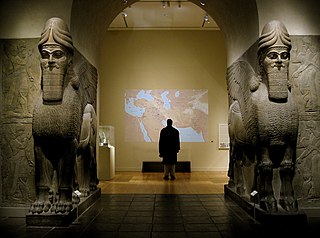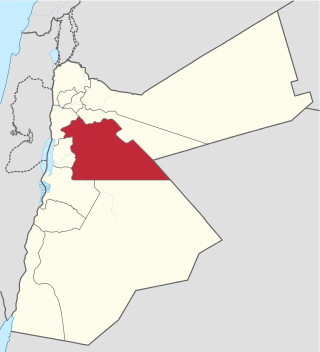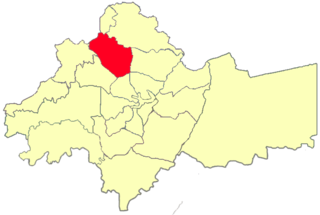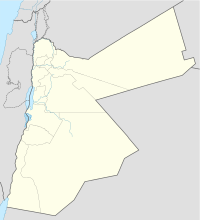
Ammon was an ancient Semitic-speaking kingdom occupying the east of the Jordan River, between the torrent valleys of Arnon and Jabbok, in present-day Jordan. The chief city of the country was Rabbah or Rabbat Ammon, site of the modern city of Amman, Jordan's capital. Milcom and Molech are named in the Hebrew Bible as the gods of Ammon. The people of this kingdom are called Children of Ammon or Ammonites.

Amman is the capital and the largest city of Jordan, and the country's economic, political, and cultural center. With a population of four million as of 2021, Amman is Jordan's primate city and is the largest city in the Levant region, the fifth-largest city in the Arab world, and the tenth-largest metropolitan area in the Middle East.

The history of Jordan refers to the history of the Hashemite Kingdom of Jordan and the background period of the Emirate of Transjordan under British protectorate as well as the general history of the region of Transjordan.

Tel Abel Beth Maacah is a large archaeological tell with a small upper northern section and a large lower southern one, connected by a saddle. It is located on the northern border of present-day Israel, about 2 km south of the town of Metula and about 6.5 km west of Tel Dan.

The architecture of Mesopotamia is ancient architecture of the region of the Tigris–Euphrates river system, encompassing several distinct cultures and spanning a period from the 10th millennium BC to the 6th century BC. Among the Mesopotamian architectural accomplishments are the development of urban planning, the courtyard house, and ziggurats. Scribes had the role of architects in drafting and managing construction for the government, nobility, or royalty.

Milcom or Milkom was the name of either the national god, or a popular god, of the Ammonites. He is attested in the Hebrew Bible and in archaeological finds from the former territory of Ammon. His connections to other deities with similar names attested in the Bible and archaeologically are debated, as well as his relationship to the Canaanite supreme deity El, or the putative deity Moloch.
Shanip was king of Ammon in the mid eighth century BCE. He is mentioned as a vassal of the Assyrian king Tiglath-Pilesar III.

Amman Governorate, officially known as Muhafazat al-Asima, is one of the governorates in Jordan. The governorate's capital is the city of Amman, which is also the country's capital. The administrative center of the governorate as well as all government offices and parliament are located in the Abdali district.

Al-Jubeiha (الجبيهة) is a city district and one of twenty-two Districts of the Greater Amman Municipality in Jordan. Al-Jubeiha has seven neighborhoods: Al-Jama'a, Al-Rasheed, Qurneh, Al-Sadiq, Al-Zaitounah, Al-Mahabah, and Al-Baladiyat.

Jordanian art has a very ancient history. Some of the earliest figurines, found at Aïn Ghazal, near Amman, have been dated to the Neolithic period. A distinct Jordanian aesthetic in art and architecture emerged as part of a broader Islamic art tradition which flourished from the 7th-century. Traditional art and craft is vested in material culture including mosaics, ceramics, weaving, silver work, music, glass-blowing and calligraphy. The rise of colonialism in North Africa and the Middle East, led to a dilution of traditional aesthetics. In the early 20th-century, following the creation of the independent nation of Jordan, a contemporary Jordanian art movement emerged and began to search for a distinctly Jordanian art aesthetic that combined both tradition and contemporary art forms.

'Iraq al-Amir or Araq el-Amir is the name shared by a town and nearby caves, within the municipality of Amman in the Jordan Valley. Located about 15 km southwest of the town of Wadi as-Seer, it has a population of about 6000 people, mostly members of the Abbadi tribe. It is located on hills with high and medium altitude, in an area with many springs and famous for its olive trees and other forest trees.

The Amman Citadel is an archeological site at the center of downtown Amman, the capital of Jordan. The L-shaped hill is one of the seven hills (jebal) that originally made up Amman.
Rujm is an Arabic word that appears as an element in numerous place names. It can be translated as 'mound, cairn, hill, spur', and also as 'stone heap' or 'tumulus'. The following is a list of place names that include Rujm as an element:
The following is a timeline of the history of the city of Amman, Kingdom of Jordan.

Tall Jawa is an archaeological and historical site in central Jordan.

Tall al-’Umayri is an archaeological dig site in western Jordan that dates from the Early Bronze Age to the Hellenistic period. It is located near the modern capital of Amman and is significant for its well-preserved evidence of a temple, as well as archaeological evidence of a network of small farms believed to have produced wine. Excavations were proceeding as of 2014.

Tell el-Hammam is an archaeological site in the Amman Governorate of Jordan, in the eastern part of the lower Jordan Valley 11.7 kilometers east of the Jordan River and not far from its mouth. It lies 12.6 kilometers northeast of the Dead Sea. The site has substantial remains from the Chalcolithic, Early, Intermediate and Middle Bronze Age, and from Iron Age II. There are different attempts at identifying the site with a biblical city. The Hammam Megalithic Field lies nearby. Other archaeological sites in the vicinity include Tall Nimrin, Tall Bleibel, Tall Mustah, Tall Iktanu, Tall Tahouna, Tall Barakat, Tall Kafrayn, and Tall Rama.

The architecture of Jordan has been subject to vast development, specifically in the final years of the twentieth century. Jordan is a semi-arid country located in the Middle East. Its location has great significance to Christians, Muslims and Jews as it is considered part of the Holy Land.
Khirbet es-Sar is an archaeological site in Jordan. It lies in the western suburb of modern Amman, on the edge of a plateau. In the MEGA Jordan database, which stores information about sites located in Jordan, Khirbet es-Sar can be found under numbers 11304 and 3007.
















